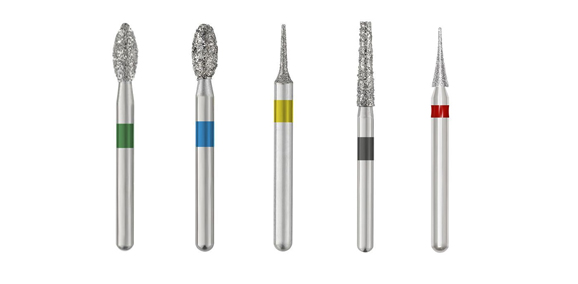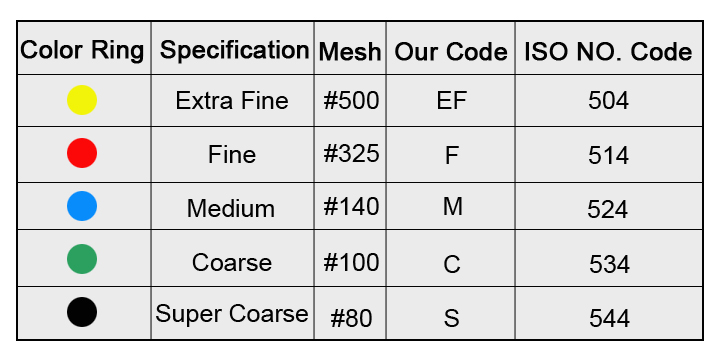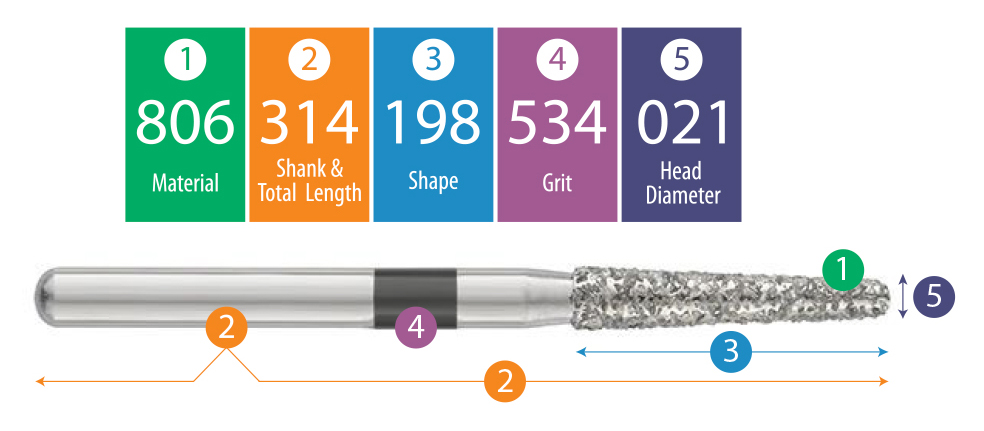What is ISO Number of A Dental Bur?
The International Organization for Standardization (ISO), a global federation of national standards organizations, introduced a new universally recognized numbering system for dental burs in 1979. This classification creates consistency and clarity among manufacturers.
The ISO classification gives specific identifiers to the parts of the bur. In the ISO system, burs are coded with a 15-digit number, which makes it easy to precisely identify any specific bur. This ISO code consists of the following 5 parts, each of which is represented by a three-digit code:
- The type of material of the bur
- The type and diameter of the bur, and length of the shank
- The shape of the head
- The size of the grit
- The maximum diameter of the head
1.The type of material of the bur
The first 3-digit set of numbers in the ISO classification refers to the type of material of the bur.
Diamond Burs (ISO 500 numbering) are used to cut tooth enamel, the hardest substance found in the hu-man body. Diamond burs feature a shank made of steel and a head coated with ei-ther synthetic or natural diamond powder.
Tungsten Carbide Burs (ISO 806 numbering) has about three times the strength of steel and is durable when cutting on various materials. These are extremely efficient, much more rigid than steel.
2.The type and diameter of the bur, and length of the shank
The second 3-digit set of numbers in the ISO classification refers to the type and diameter of the bur, and length of the shank.
The 1-digit 1/2/3 refers to HP/RA/FG.
HP (Long Straight Shank)
These shanks fit into the nose cone of the slow speed handpiece once the prophy angle or contra angle is removed. They are used for diamond cutting discs or long 40mm burs. The main use of HP burs is in the trimming of small herbivore cheek teeth.
RA (Latch-type Shank)
These shanks fit into the latch of the contra-angle on slow speed handpieces. They are generally 20mm long and available in the same shapes as FG burs.
FG (Friction Grip Shank)
These shanks fit into the turbine of a high-speed handpiece. The standard length is 20mm long, but longer surgical lengths are available and these are commonly needed for veterinary work.
The “4” in the last digit represents the regular length. If less than 4 refers to ultra-short; more than 4 refers to special length, respectively.
3.The shape of the head
The third 3-digit set of numbers in the ISO classification refers to the shape of the head. For example, ISO 233 means inverted cone.
- Ball burs are typically used for cutting, grinding, and removing hard and soft tissues.
- Inverted cone burs are often used to open cavities or make undercuts during dental surgery.
- Conical burs have flat or rounded tips. The former type is often used for chamfering.
- Wheel burs are typically used to make occlusal shapes, deep cuts, or mechanical retentions.

4.The size of the grit
The fourth 3-digit set of numbers in the ISO classification refers to the size of the grit.
White: superfine (ISO: 594)
Yellow: extra-fine (ISO: 504)
Red-fine (ISO: 514)
Blue/No Ring: standard (ISO: 524)
Green: coarse (ISO: 534)
Black: super coarse (ISO: 544)

5.The maximum diameter of the head
The last 3-digit set of numbers in the ISO classification refers to the maximum diameter of the head of the bur.
ISO 021 means the maximum diameter of the head of the bur is 21mm.



